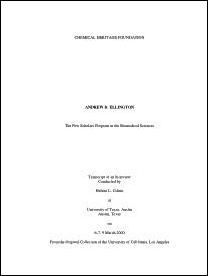Jerry R. Faust began his childhood on his father's farm in rural Texas. When his parents divorced he moved with his mother, a nurse, and his brother to Dallas, Texas, where he attended junior high school and high school. When he was in eighth grade he took an advanced biology class in which the newly-discovered ATP was discussed at length, but in high school he "left biology" for chemistry. He loved chemistry, a field that was really taking off at the time. A high school chemistry teacher proved an important role model, and an influential school trip to a research laboratory confirmed his desire to become a scientist. Faust's chemistry teacher was also the basketball coach, and Faust played well enough to be offered a basketball scholarship to Stephen F. Austin State University. As he says, he went to college to play basketball, not to learn, so he rejected an offer from Rice University, as studying might have gotten in the way of basketball. At Austin State he declared a major in chemistry and minored in biology, soon developing an interest in biochemistry. He considered working in biochemistry to be a way to make a contribution to society. After graduation Faust took a position as a chemist. He spent a boring year testing materials before deciding to go to graduate school. He took a biochemistry course taught by Edward Bellion, and entered his lab at University of Texas at Arlington. There he continued to develop his interest in biochemistry. He felt he had certain advantages coming to biochemistry as a chemist rather than a biologist. After finishing a master's degree, Faust accepted a position as research associate in the Michael S. Brown and Joseph L. Goldstein lab at the University of Texas Southwestern Medical Center in Dallas. Faust describes Brown's and Goldstein's backgrounds; his role in the lab's work on cholesterol metabolism; and learning opportunities in the lab. He also explains their Nobel Prize for research into LDL. After being there for eleven years he went to E. I. DuPont de Nemours and Company as a principal investigator in the cardiology unit. Faust describes the structure and research resources of the Du Pont Experimental Station and his projects there. He explains his professional satisfaction in designing and implementing research per se, irrespective of clinical applications. Faust's preference for following tangents rather than pursuing a strictly linear line of research led him next to the decision to pursue a PhD in the physiology department at Tufts University, where he entered James Fred Dice's lab. Being a student again was different and strange. Here he discusses how the need to meet funding requirements affects the direction of research; the value of funding sources that allow for creative research; and the advantages of increasing cooperation between labs. He continues with a discussion of Dice as a mentor; his own mentoring and managing style; influence on his research of the Pew Scholars Program in the Biomedical Sciences award; grant writing; and competition with Peter Pentchev's lab over work on cholesterol transport in Niemann-Pick type C disease. He has more to say about the competition with the Pentchev lab; differences between the grant review process at the National Science Foundation and that at the National Institutes of Health; science funding in general; and his lab's work on neuronal ceroid lipfuscinosis. Collaboration with foreign labs leads to foreign students, difficult to fund and difficult to place after graduation, especially since principal investigator positions are so scarce. He finishes with a description of how he and his partner, also a scientist at Tufts with whom he collaborates on projects, balance their work life with their home life.
See our FAQ page to learn how to cite an oral history.









